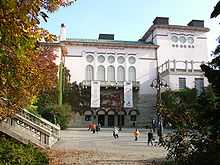István Medgyaszay


Istvan Medgyaszy (Budapest, 23 August 1877 - Budapest, 29 April 1959) was a Hungarian architect and writer.[1] He was one of the first to employ Hungarian folk idioms, particularly from Transylvania, and combine them with influences ranging from the far east to organic architecture.
Medgyaszay studied at the Vienna Academy of Fine Arts and also at the Budapest Academy.[1] He won the commission for the design of the national pantheon in 1903 and graduated the following year. After further studies abroad he returned home and began working on the combination of reinforced concrete technology with folkloric design elements. He also travelled to northern Africa and India to study the architecture there.
Medgyaszay had a successful academic career and was highly regarded until the communist takeover in the late 1940s when he was criticised for his apolitical or so-called formalist approach to art. He stopped working in 1959 and died three weeks later.
Main works
- National pantheon, 1903, not built (won 5 European prizes for this plan)
- Milan exposition pavilion, 1906
- Artists homes, Gödöllő, 1904–06
- Theatre, Veszprém, 1908
- Theatre, Sopron, 1908–09
- Budapest Opera House, rebuilding, 1912
- Theatre, Miskolc, rebuilding, 1922
- Various church buildings: Rárósmúlyad (1910); Ógyalla (1912); Püspökladány (1921); Kenderes (1922); Csillaghegy (1935)
| Wikimedia Commons has media related to Buildings by István Medgyaszay. |
References
- ↑ 1.0 1.1 Medgyaszay István, Hungarian Electronic Library, retrieved 13 May 2012 (Hungarian)
|